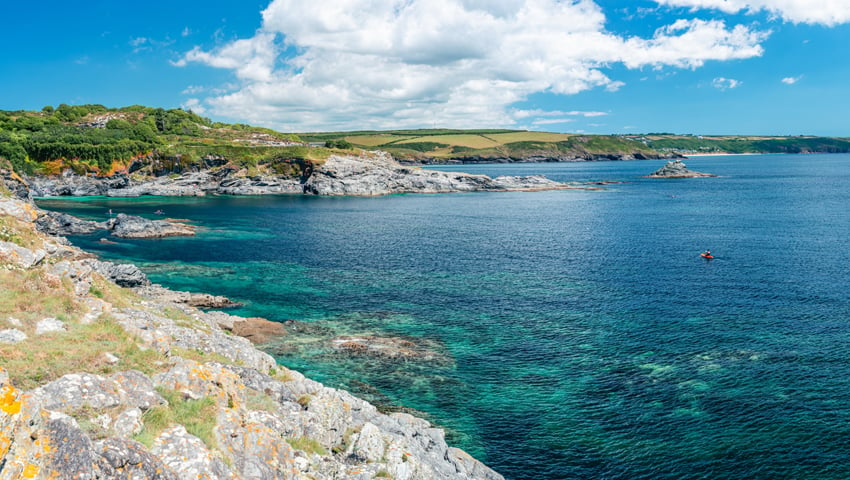Tor to Shore aims to create a thriving landscape rich in wildlife, from the large granite boulders and heights of Helman Tor in central Cornwall, through the Par River and surrounding farmland, to Cornwall’s south coast.
One of the UK’s most ambitious rewilding projects is unveiled in Cornwall today thanks to significant new investment from The National Lottery Heritage Fund.
Tor to Shore aims to create a thriving landscape rich in wildlife, from the large granite boulders and heights of Helman Tor in central Cornwall, through the Par River and surrounding farmland, to Cornwall’s south coast. The project will also protect and restore marine habitats in St Austell Bay, including maerl beds that have potentially existed for more than 4,000 years.
Cornwall Wildlife Trust has been awarded a £265,000 development grant to progress plans and introduce pioneering conservation techniques, including the implementation of rewilding principles at Helman Tor nature reserve. This could lead to over £3 million of further funding for nature in Cornwall.
Cornwall may be famed for its rugged coastline and turquoise waters, but the county’s natural beauty masks the hard truth that wildlife is in trouble – both on land and at sea. The most recent State of Nature report for Cornwall revealed that almost a quarter of mammals and butterfly species are at risk of extinction, and that the ‘richest’ sites for wildlife are too disconnected from each other.
Matt Walpole, Chief Executive of Cornwall Wildlife Trust, said, “For too long conservation efforts on land and those at sea have been fragmented. Cornwall Wildlife Trust is thrilled to receive funding from The National Lottery Heritage Fund to change that, demonstrating that joined up efforts to create bigger, better, more connected landscapes and seascapes can be transformative for nature recovery.”
Tor to Shore builds on work carried out by Cornwall Wildlife Trust over the past 18 months. At over 730 acres, Helman Tor, a focal area for the project, is the Trust’s largest nature reserve and home to interesting and rare wildlife. Historically, it has been managed by traditional, human-led conservation activities, including the manual clearance of dominant habitats, to maintain its carefully balanced ecosystem for wildlife. However, over the past 12 months, the Trust has started rewilding the reserve. Tamworth pigs and English Longhorn cattle, both ancient breeds with behaviours and habits that benefit nature, now roam, rootle and graze amongst wet woodland and heathland, while in February, two beavers unexpectedly arrived at the site.
There are now a few small pockets of beavers in the wild across England. The pair at Helman Tor have started establishing a territory and building dams. As a local conservation charity, Cornwall Wildlife Trust is managing their presence and working with locals to minimise any unwanted effects. The charity still plans on applying for a wild release licence for Helman Tor when the Government process opens.
While Helman Tor sits near the top of the Par River, areas downstream are surrounded by farmland, where the project will partner with local farmers to tackle agricultural pollution and create wildlife corridors – areas of habitat that span from Helman Tor and connect with other nature-rich sites, allowing wildlife to thrive beyond the reserve’s boundaries.
And finally, following the journey of the Par River, is St Austell Bay. In 2023, Cornwall Wildlife Trust research confirmed one of the UK’s largest subtidal seagrass beds exists in the bay. Moreover, it was found to also be home to extensive maerl beds, a lesser known but equally important habitat. Maerl is a hard, calcified seaweed that forms over long periods of time, and St Austell Bay’s beds are likely thousands of years old. Marine wildlife can be found sheltering within and feeding among the maerl, which, like seagrass, is an important habitat for carbon capture.
Protecting it is now a priority for Cornwall Wildlife Trust – particularly following its recent classification by Natural England as ‘irreplaceable’, largely due to the extremely long time it takes to develop (growing as little as 0.5mm per year).
Ruth Williams, Head of Marine at Cornwall Wildlife Trust, said, “Locally known as ‘Cornish coral’, maerl beds are spectacular. rich pink and purple in colour, they provide a home for marine wildlife, including bull huss (a small member of the shark family), urchins, and various fish. We’re lucky to have it in St Austell Bay but cannot take it for granted.”
At the heart of Cornwall Wildlife Trust’s ambitions for the area are plans to bring together people and communities from all backgrounds to act for, connect with, and benefit from nature.
Tor to Shore’s development phase, funded by The National Lottery Heritage Fund, will engage stakeholders in the project area to lay the groundwork for a community-focused approach for nature’s recovery across land and sea.
